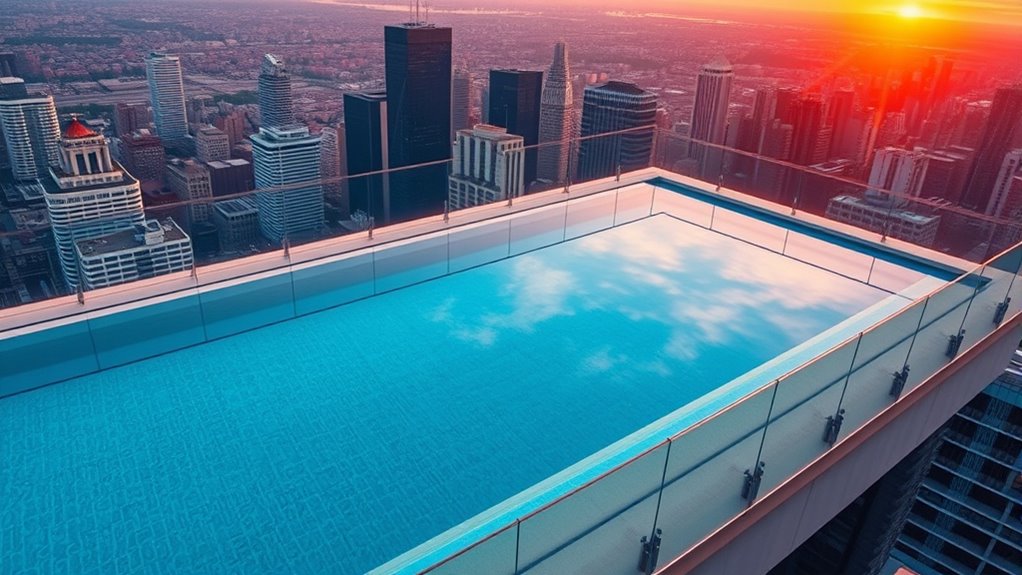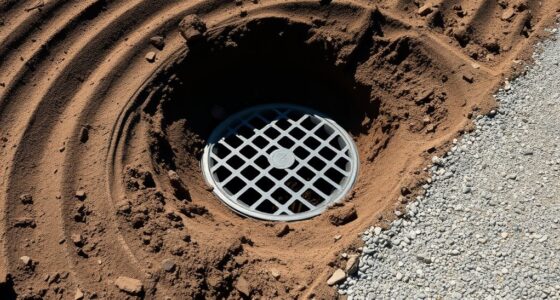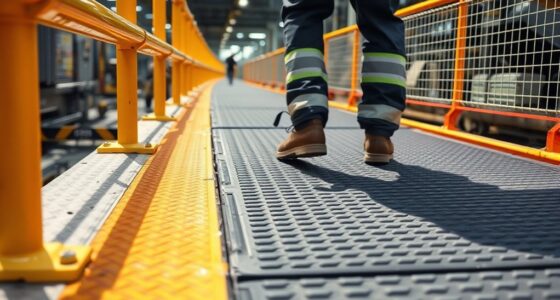When building a rooftop infinity pool, you must guarantee the structure can handle the weight and stress. Use strong foundations and materials like reinforced concrete for support, and install waterproofing layers such as membranes to prevent leaks. Proper design of overflow systems and accounting for thermal movement are essential to maintain durability. If you continue exploring, you’ll discover detailed strategies to create a safe, long-lasting infinity pool that complements your rooftop space.
Key Takeaways
- Ensure rooftop structures can support water weight, installing reinforced foundations and load-distributing elements for safety.
- Select durable waterproof membranes like PVC or TPO and proper drainage systems to prevent leaks and water damage.
- Design spillover edges and overflow channels to maintain water level control and seamless infinity effects.
- Incorporate expansion joints and flexible materials to accommodate temperature-induced movements and prevent structural stress.
- Regularly inspect and maintain waterproofing and structural components to ensure longevity and visual appeal of rooftop infinity pools.
Understanding the Structural Support Requirements

Since rooftop infinity pools are heavy structures, understanding their structural support requirements is essential for safety and stability. You need to verify the building’s framework can handle the weight of the water, pool materials, and additional loads like people and equipment. Consult a structural engineer early in the planning process to assess load-bearing capacity accurately. Reinforcing existing structures might be necessary, especially if the roof wasn’t originally designed to support such weight. You should also consider dynamic loads from movement and water displacement, which can increase stress on supports. Proper design ensures that the structure can distribute these loads evenly, preventing cracks, sagging, or failure. Additionally, considering building safety standards is crucial to meet local regulations and ensure long-term durability. Prioritizing these support considerations safeguards your investment and provides peace of mind.
Foundations and Load-Bearing Considerations

Establishing solid foundations is crucial for supporting a rooftop infinity pool, as they bear the entire weight of the structure and water. Your foundation must handle heavy loads, including the pool’s weight, water, and dynamic movements. You’ll need to assess the building’s existing structural capacity or reinforce it accordingly. Proper load distribution prevents stress on the building and minimizes risks like cracks or failure. Incorporating high load capacity materials ensures the foundation can withstand the significant stresses imposed by the pool.
A strong foundation ensures safety and stability for rooftop infinity pools, supporting heavy loads and preventing structural failure.
Imagine:
- Reinforced concrete slabs spreading the weight evenly across the rooftop surface
- Deep pilings anchoring the structure to stable soil or bedrock below
- Support beams designed to distribute forces and resist shifting or settling
These elements work together to ensure safety, stability, and longevity, safeguarding your investment and the building’s integrity.
Materials Commonly Used in Structural Frameworks

When constructing the structural framework for a rooftop infinity pool, selecting the right materials is essential to guarantee strength and durability. Common choices include reinforced concrete, structural steel, and sometimes wood for aesthetic elements. Reinforced concrete offers high compressive strength and durability, making it ideal for supporting heavy water loads. Structural steel provides excellent tensile strength and flexibility, often used in conjunction with concrete. Wood is rarely used structurally but can add decorative appeal. Here’s a quick comparison:
| Material | Strength | Durability | Cost |
|---|---|---|---|
| Reinforced Concrete | High compressive | Very durable | Moderate |
| Structural Steel | High tensile | Good with proper treatment | Higher |
| Wood | Moderate | Lower, needs maintenance | Lower |
Choosing the right material depends on load requirements, budget, and design preferences. Additionally, understanding payment processing can be essential when managing project budgets and supplier payments efficiently.
Waterproofing Techniques for Rooftop Pools
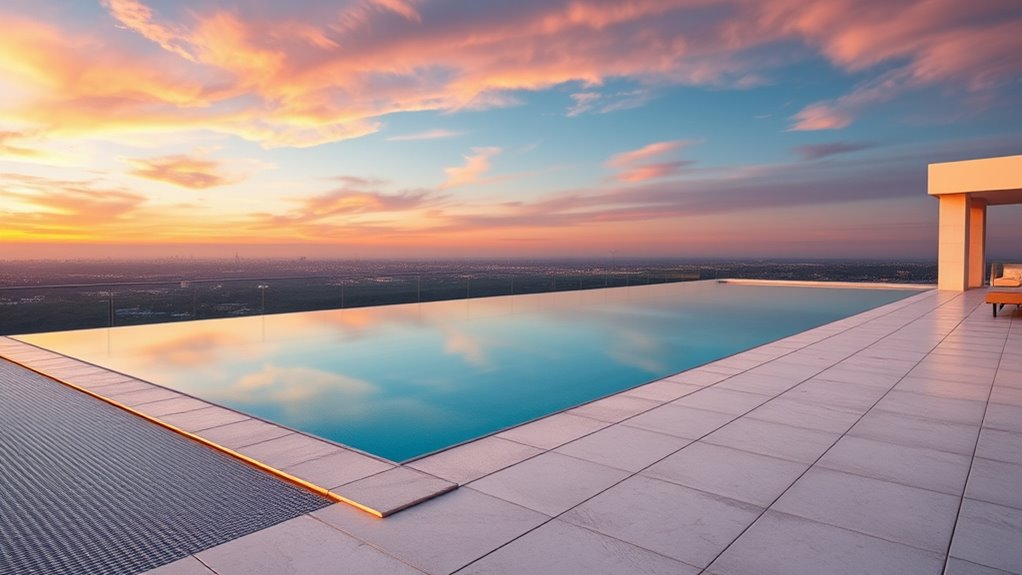
Choosing the right membrane material is essential to keep your rooftop pool watertight and durable. You also need an effective drainage system to prevent water accumulation and damage. Together, these techniques guarantee your infinity pool remains safe and functional over time. Additionally, understanding IRA tax implications can help optimize your investment and ensure long-term financial benefits.
Membrane Material Selection
Selecting the right membrane material is essential for guaranteeing a durable and effective waterproofing layer in rooftop infinity pools. You need a material that can withstand constant exposure to water, UV rays, and temperature changes without deteriorating. Consider options like PVC, TPO, or liquid-applied membranes, each offering unique benefits. Visualize walking along the edge, where the membrane acts as a reliable barrier beneath the sleek surface. Imagine the seamless, flexible layer conforming perfectly to the pool’s contours, preventing leaks and water damage. Think about a membrane that’s easy to install, resistant to punctures, and compatible with your pool’s design. Choosing the right material ensures longevity, safety, and the stunning visual effect of an infinity edge that remains flawless over time. Vetted options such as the Flat Iron Bike demonstrate the importance of reliable, high-performance components that withstand rigorous use and environmental stressors.
Proper Drainage Systems
Effective drainage systems are essential for preventing water accumulation and safeguarding your rooftop pool’s structure. Proper drainage directs excess water away, reducing pressure on waterproofing layers and preventing leaks. You should install a network of outlets and slopes that guide water efficiently toward drainage points. Ensure that your drainage system accounts for heavy rain and pool overflows, preventing pooling on the deck and structural damage.
| Drainage Component | Purpose |
|---|---|
| Outlets | Remove excess water quickly |
| Sloped Surface | Guide water toward drainage points |
| Drainage Piping | Transport water safely away |
| Overflow Channels | Manage heavy rain or spillovers |
| Inspection Access | Enable maintenance and block checks |
Properly planned drainage keeps your rooftop pool safe, functional, and long-lasting.
Designing the Overflow and Spillover Systems

When designing your overflow and spillover systems, consider where to place the overflow channels for ideal water flow. The spillover edge shape influences both aesthetics and functionality, so choose a design that complements your pool’s look. Additionally, controlling the water level ensures your system operates smoothly without overflows or dry spots. Implementing proper security measures in your design can also help prevent unauthorized access or damage to your system.
Overflow Channel Placement
Proper placement of the overflow channel is crucial to guarantee that excess water from the infinity pool seamlessly flows into the spillover system without compromising the pool’s aesthetic or safety. You want the channel positioned where water naturally gravitates, typically along the edges or at specific points that facilitate smooth drainage. This ensures that water doesn’t spill over unpredictably or cause splashing. When planning placement, consider the pool’s shape, the flow rate, and the visual impact. Visualize the channel running discreetly along the edge, hidden from view but still effective. Think of it as a quiet pathway guiding excess water off the deck. Proper positioning minimizes maintenance issues and keeps your rooftop pool looking pristine and safe. Additionally, integrating vertical storage solutions can help store maintenance supplies and safety equipment nearby, simplifying upkeep and ensuring quick access when needed.
Spillover Edge Design
Designing the spillover edge is vital to guarantee your rooftop infinity pool maintains its seamless visual effect while functioning efficiently. You need to select a precise height and angle for the edge to create the illusion of water extending to the horizon. The spillover must be smooth and continuous, avoiding any gaps or irregularities that could disrupt the aesthetic. Incorporate a slight slope to ensure water flows evenly over the edge without splashing or splattering. Use durable, waterproof materials that can withstand weather and pool chemicals. Properly sealed joints prevent leaks and maintain the clean, sleek look. Remember, the spillover edge not only enhances your pool’s visual appeal but also plays an essential role in its water circulation and safety. Paying attention to dynamic communication exercises can help ensure your team stays aligned during installation and maintenance, reducing errors and improving overall quality.
Water Level Control
To guarantee your rooftop infinity pool maintains a consistent water level and a stunning visual flow, you need to carefully plan the overflow and spillover systems. These systems regulate water height, prevent overflows, and enhance the pool’s aesthetic. Proper design ensures water gently cascades over the edge, creating that seamless infinity effect. Think about:
- Precision-engineered overflow channels that direct excess water smoothly into the catch basin
- Spillover edges shaped to maintain a uniform water level across the surface
- A well-placed drainage system that quickly handles surges during heavy rain or usage
- Incorporating good lighting to highlight water flow and enhance the overall ambiance of the infinity edge.
Addressing Thermal Expansion and Movement
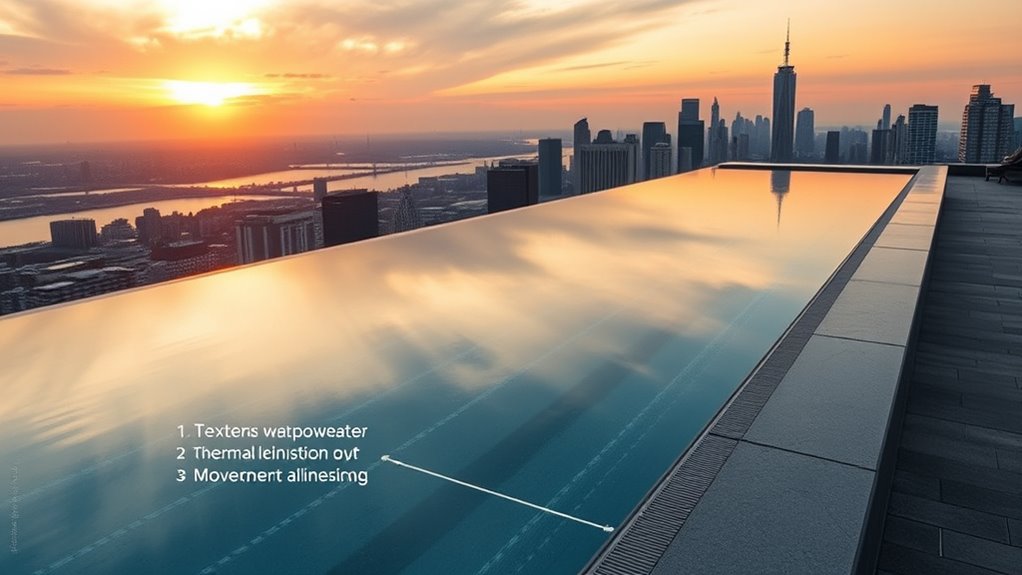
Thermal expansion and movement are critical factors to consider when installing rooftop infinity pools, as temperature fluctuations can cause materials to expand or contract considerably. You need to allow for this movement to prevent structural stress or cracks. Use expansion joints strategically to accommodate these shifts, especially around perimeter edges and where the pool meets the building structure. Select materials with suitable thermal properties, such as flexible sealants and adaptable concrete mixes. Ensure your design includes sufficient gaps and movement allowances to absorb expansion without compromising waterproofing or structural integrity. Regularly verify that these components function correctly, especially during temperature extremes. Addressing thermal movement early on protects your investment, ensuring longevity and safety for your rooftop infinity pool. Incorporating appropriate materials that respond well to thermal changes can further enhance the durability of the structure.
Maintenance and Inspection for Longevity
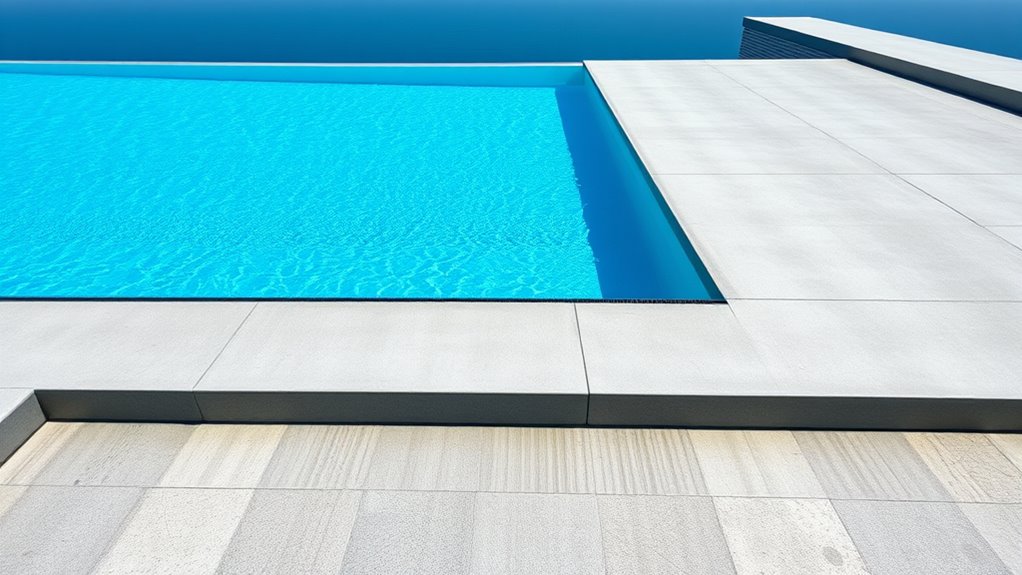
Regular maintenance and diligent inspections are essential to guarantee your rooftop infinity pool remains safe, functional, and visually stunning over time. By checking for leaks, cracks, and signs of wear, you catch issues early before they escalate. Regular brushing of the waterproofing membrane helps prevent algae and debris buildup, preserving its integrity. Additionally, monitoring the structural components ensures your pool stays secure amid temperature changes and movement.
Imagine walking onto your rooftop, seeing pristine water, and knowing you’ve kept everything in top shape. To achieve this, focus on:
- Inspecting joints and seams for cracks or deterioration
- Cleaning filters and drainage systems thoroughly
- Testing waterproofing layers for damage or leaks
Consistent care safeguards your investment and extends your pool’s lifespan.
Frequently Asked Questions
What Are the Latest Innovations in Rooftop Pool Waterproofing Technology?
You’ll find that the latest innovations in rooftop pool waterproofing include advanced liquid membranes with improved flexibility and UV resistance, ensuring durability under harsh weather. Self-healing materials are gaining popularity, automatically sealing small cracks to prevent leaks. Additionally, spray-applied waterproofing systems offer seamless, quick application, reducing installation time. These new technologies help you achieve long-lasting, reliable waterproofing, making your rooftop infinity pool safer and more resilient against water damage.
How Do Climate Conditions Affect Rooftop Infinity Pool Design and Construction?
You might think climate risks are negligible, but they dramatically shape your rooftop infinity pool’s design. Heavy rain demands robust drainage systems, while intense sun necessitates UV-resistant materials. Freezing temperatures require insulation and flexible waterproofing to prevent cracks. Ignoring these factors could turn your luxury oasis into a costly disaster. So, you must tailor your construction to your climate’s quirks, ensuring durability and safety amidst nature’s unpredictable whims.
What Safety Features Are Essential for Rooftop Infinity Pools?
You should include essential safety features like sturdy, non-slip surfaces around the pool, secure fencing or barriers to prevent accidental falls, and reliable drainage systems to avoid water accumulation. Install safety alarms and ensure proper lighting for visibility at night. Regularly inspect the structural integrity and waterproofing to prevent leaks or accidents. These measures safeguard everyone and maintain a safe, enjoyable environment for your rooftop infinity pool.
How Can Noise and Vibration Be Minimized in Rooftop Pool Installations?
You can minimize noise and vibration by installing resilient mounts and vibration dampers beneath the pool structure, guaranteeing they absorb movement. Using soundproof insulation around machinery and plumbing also helps reduce noise transfer. Regular maintenance prevents issues that cause vibrations, like loose fittings. While some worry about added costs, investing in these measures ensures a quieter, more comfortable environment, making your rooftop infinity pool a true luxury retreat.
What Are the Environmental Considerations for Rooftop Pool Construction?
You should consider environmental factors like local climate, wind loads, and sunlight exposure when constructing a rooftop pool. Use eco-friendly materials to reduce pollution and energy consumption. Plan for proper drainage to prevent runoff issues and protect surrounding areas. Incorporate energy-efficient systems, like solar heating, to minimize your environmental impact. Additionally, guarantee the structure can withstand seismic activity and extreme weather to make your rooftop pool both sustainable and safe.
Conclusion
By mastering the meticulous methods of maintenance and monitoring, you guarantee your rooftop infinity pool remains pristine and protected. Regular inspections reinforce structural strength, while strategic waterproofing wards off water woes. Staying proactive with precise planning and persistent preservation transforms your terrace into a tranquil, timeless oasis. Remember, diligent diligence and dedicated care deliver durability, distinction, and a dazzling, danger-free display of design and dedication.
